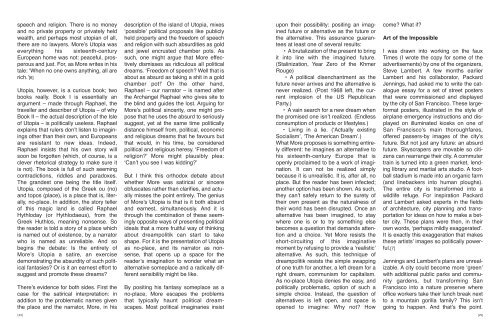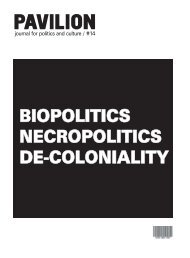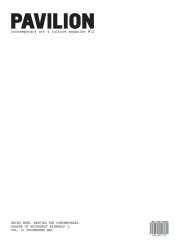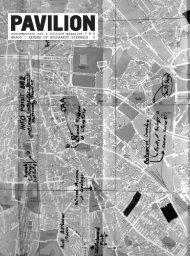Download pdf version of issue no. 16 (4 Mb) - Pavilion
Download pdf version of issue no. 16 (4 Mb) - Pavilion
Download pdf version of issue no. 16 (4 Mb) - Pavilion
You also want an ePaper? Increase the reach of your titles
YUMPU automatically turns print PDFs into web optimized ePapers that Google loves.
speech and religion. There is <strong>no</strong> money<br />
and <strong>no</strong> private property or privately held<br />
wealth, and perhaps most utopian <strong>of</strong> all,<br />
there are <strong>no</strong> lawyers. More’s Utopia was<br />
everything his sixteenth-century<br />
European home was <strong>no</strong>t: peaceful, prosperous<br />
and just. For, as More writes in his<br />
tale: ‘When <strong>no</strong> one owns anything, all are<br />
rich.’[6]<br />
Utopia, however, is a curious book; two<br />
books really. Book I is essentially an<br />
argument – made through Raphael, the<br />
traveller and describer <strong>of</strong> Utopia – <strong>of</strong> why<br />
Book II – the actual description <strong>of</strong> the Isle<br />
<strong>of</strong> Utopia – is politically useless. Raphael<br />
explains that rulers don’t listen to imaginings<br />
other than their own, and Europeans<br />
are resistant to new ideas. Indeed,<br />
Raphael insists that his own story will<br />
soon be forgotten (which, <strong>of</strong> course, is a<br />
clever rhetorical strategy to make sure it<br />
is <strong>no</strong>t). The book is full <strong>of</strong> such seeming<br />
contradictions, riddles and paradoxes.<br />
The grandest one being the title itself.<br />
Utopia, composed <strong>of</strong> the Greek ou (<strong>no</strong>)<br />
and topos (place), is a place that is, literally,<br />
<strong>no</strong>-place. In addition, the story teller<br />
<strong>of</strong> this magic land is called Raphael<br />
Hythloday (or Hythlodaeus), from the<br />
Greek Huthlos, meaning <strong>no</strong>nsense. So<br />
the reader is told a story <strong>of</strong> a place which<br />
is named out <strong>of</strong> existence, by a narrator<br />
who is named as unreliable. And so<br />
begins the debate: Is the entirety <strong>of</strong><br />
More’s Utopia a satire, an exercise<br />
demonstrating the absurdity <strong>of</strong> such political<br />
fantasies? Or is it an earnest effort to<br />
suggest and promote these dreams?<br />
There’s evidence for both sides. First the<br />
case for the satirical interpretation: in<br />
addition to the problematic names given<br />
the place and the narrator, More, in his<br />
[24]<br />
description <strong>of</strong> the island <strong>of</strong> Utopia, mixes<br />
‘possible’ political proposals like publicly<br />
held property and the freedom <strong>of</strong> speech<br />
and religion with such absurdities as gold<br />
and jewel encrusted chamber pots. As<br />
such, one might argue that More effectively<br />
dismisses as ridiculous all political<br />
dreams. ‘Freedom <strong>of</strong> speech? Well that is<br />
about as absurd as taking a shit in a gold<br />
chamber pot!’ On the other hand,<br />
Raphael – our narrator – is named after<br />
the Archangel Raphael who gives site to<br />
the blind and guides the lost. Arguing for<br />
More’s political sincerity, one might propose<br />
that he uses the absurd to seriously<br />
suggest, yet at the same time politically<br />
distance himself from, political, eco<strong>no</strong>mic<br />
and religious dreams that he favours but<br />
that would, in his time, be considered<br />
political and religious heresy. ‘Freedom <strong>of</strong><br />
religion?’ More might plausibly plea:<br />
‘Can’t you see I was kidding?’<br />
But I think this orthodox debate about<br />
whether More was satirical or sincere<br />
obfuscates rather than clarifies, and actually<br />
misses the point entirely. The genius<br />
<strong>of</strong> More’s Utopia is that is it both absurd<br />
and earnest, simultaneously. And it is<br />
through the combination <strong>of</strong> these seemingly<br />
opposite ways <strong>of</strong> presenting political<br />
ideals that a more fruitful way <strong>of</strong> thinking<br />
about dreampolitik can start to take<br />
shape. For it is the presentation <strong>of</strong> Utopia<br />
as <strong>no</strong>-place, and its narrator as <strong>no</strong>nsense,<br />
that opens up a space for the<br />
reader’s imagination to wonder what an<br />
alternative someplace and a radically different<br />
sensibility might be like.<br />
By positing his fantasy someplace as a<br />
<strong>no</strong>-place, More escapes the problems<br />
that typically haunt political dreamscapes.<br />
Most political imaginaries insist<br />
upon their possibility: positing an imagined<br />
future or alternative as the future or<br />
the alternative. This assurance guarantees<br />
at least one <strong>of</strong> several results:<br />
• A brutalization <strong>of</strong> the present to bring<br />
it into line with the imagined future.<br />
(Stalinization, Year Zero <strong>of</strong> the Khmer<br />
Rouge)<br />
• A political disenchantment as the<br />
future never arrives and the alternative is<br />
never realized. (Post 1968 left, the current<br />
implosion <strong>of</strong> the US Republican<br />
Party.)<br />
• A vain search for a new dream when<br />
the promised one isn’t realized. (Endless<br />
consumption <strong>of</strong> products or lifestyles.)<br />
• Living in a lie. (‘Actually existing<br />
Socialism’, ‘The American Dream’.)<br />
What More proposes is something entirely<br />
different: he imagines an alternative to<br />
his sixteenth-century Europe that is<br />
openly proclaimed to be a work <strong>of</strong> imagination.<br />
It can <strong>no</strong>t be realized simply<br />
because it is unrealistic. It is, after all, <strong>no</strong><br />
place. But the reader has been infected;<br />
a<strong>no</strong>ther option has been shown. As such,<br />
they can’t safely return to the surety <strong>of</strong><br />
their own present as the naturalness <strong>of</strong><br />
their world has been disrupted. Once an<br />
alternative has been imagined, to stay<br />
where one is or to try something else<br />
becomes a question that demands attention<br />
and a choice. Yet More resists the<br />
short-circuiting <strong>of</strong> this imaginative<br />
moment by refusing to provide a ‘realistic’<br />
alternative. As such, this technique <strong>of</strong><br />
dreampolitik resists the simple swapping<br />
<strong>of</strong> one truth for a<strong>no</strong>ther, a left dream for a<br />
right dream, communism for capitalism.<br />
As <strong>no</strong>-place Utopia denies the easy, and<br />
politically problematic, option <strong>of</strong> such a<br />
simple choice. Instead, the question <strong>of</strong><br />
alternatives is left open, and space is<br />
opened to imagine: Why <strong>no</strong>t? How<br />
come? What if?<br />
Art <strong>of</strong> the Impossible<br />
I was drawn into working on the faux<br />
Times (I wrote the copy for some <strong>of</strong> the<br />
advertisements) by one <strong>of</strong> the organizers,<br />
Steve Lambert. A few months earlier<br />
Lambert and his collaborator, Packard<br />
Jennings, had asked me to write the catalogue<br />
essay for a set <strong>of</strong> street posters<br />
that were commissioned and displayed<br />
by the city <strong>of</strong> San Francisco. These largeformat<br />
posters, illustrated in the style <strong>of</strong><br />
airplane emergency instructions and displayed<br />
on illuminated kiosks on one <strong>of</strong><br />
San Francisco’s main thoroughfares,<br />
<strong>of</strong>fered passers-by images <strong>of</strong> the city’s<br />
future. But <strong>no</strong>t just any future: an absurd<br />
future. Skyscrapers are movable so citizens<br />
can rearrange their city. A commuter<br />
train is turned into a green market, lending<br />
library and martial arts studio. A football<br />
stadium is made into an organic farm<br />
(and linebackers into human ploughs).<br />
The entire city is transformed into a<br />
wildlife refuge. For inspiration Packard<br />
and Lambert asked experts in the fields<br />
<strong>of</strong> architecture, city planning and transportation<br />
for ideas on how to make a better<br />
city. These plans were then, in their<br />
own words, ‘perhaps mildly exaggerated’.<br />
It is exactly this exaggeration that makes<br />
these artists’ images so politically powerful.[7]<br />
Jennings and Lambert’s plans are unrealizable.<br />
A city could become more ‘green’<br />
with additional public parks and community<br />
gardens, but transforming San<br />
Francisco into a nature preserve where<br />
<strong>of</strong>fice workers take their lunch break next<br />
to a mountain gorilla family? This isn’t<br />
going to happen. And that’s the point.<br />
[25]








